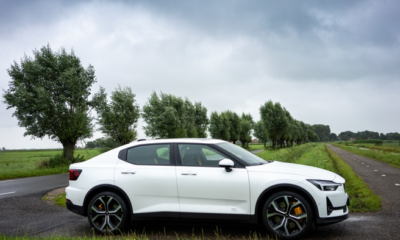Car News
What Tesla’s EV Pickup Truck Needs to Beat the Rivian R1T
With the electric pickup wars heating up, the “Cybertruck” need to bring it.
The Tesla “Cybertruck” electric pickup truck may be the automaker’s boldest play yet, one that any truck enthusiast should pay attention to, as Elon Musk will pull the covers off on November 21. But the much-hyped vehicle already has to hit ludicrous speed to catch up to the Rivian R1T, which has enjoyed a yearlong headstart to capture the world’s attention. Soon, Tesla’s outspoken CEO can end his Twitter teaser campaign and share all the real-deal details of his company’s ambitious segment-buster. How will they compare to the specs of Rivian’s equally ambitious foray? Here are the features we hope to see from the Tesla truck that could give it an edge in the nascent EV-pickup game.
1. Ultra Long Range
Similar to Tesla vehicles, the R1T uses a “skateboard” chassis with its batteries mounted low and flat in the floor. It’s likely the Tesla truck will use a similar layout, but the company’s battery engineers are going to have to go big to match Rivian: The R1T is designed to carry as large as a 180-kWh “MegaPack” battery that is said to provide more than 400 miles of range.
Truck owners who do long-haul towing need to know their vehicle has excellent endurance. Rivian’s claimed range exceeds that of any current Tesla car, but it’s also physically a much larger vehicle. The Tesla truck will likely be longer and wider than the Model S or Model X, providing more space for batteries. It’s unclear how big the Tesla truck will be or what it will look like, though, and teasers like the one above seem to pose more questions than answers. But if it can crack 500 unladen miles on a charge, it’ll help put dedicated road warriors’ range anxiety to rest—no matter how it ends up looking.
2. Off-Road Excellence
Rivian wants R1T customers to have the freedom to get down and dirty. It’s engineered the truck to impress off-road, with better approach, departure, and break-over angles than a Toyota Tacoma, and adjustable air suspension that can provide more ground clearance than a Jeep Gladiator Rubicon. Each of the R1T’s transmission outputs are located centrally under the vehicle, allowing long halfshafts to be fitted for more wheel articulation. Furthermore, precision torque vectoring is provided by a dedicated electric motor for each wheel, making it easier for the truck to crawl over loose and technical terrain.
Of course, there’s little to stop Tesla Cybertruck designers from building in competitive angles and ride height. Like the Rivian, it should get substantial underbody protection to shield the batteries from terrain impacts. And air suspension isn’t new to Tesla; the Model S and X ride on height-adjustable air springs. But so far, Teslas have been offered with up to two motors, one for each axle. With Track Mode, the Model 3 can vector torque, albeit using the brakes. Going for a quad-motor setup would be a new approach for Tesla, but would have awesome benefits for its truck’s capability off pavement or in inclement weather. Whatever the case, Team Tesla should work to make its truck as rugged as any other. Maybe it will go so far as to start installing Superchargers at trailheads.
3. Towing-Tuned Autopilot
There’s a certain art to towing with a truck, one that only comes from practice and real-world experience. Can machines do a better job? Rivian claims the R1T will be able to tow 11,000 pounds, and that it’ll have a full suite of autonomous driving features that rely on cameras, lidar, radar, and ultrasonic sensors. But the brand’s made no mention of how that technology might improve towing capabilities.
4. Heavy-Duty Capability
The R1T packs some clever ways to carry cargo, namely the pass-through “Gear Tunnel” between the cab and bed, and the roomy frunk afforded by the absence of an engine. However, its more traditional capacities leave something to be desired. The only bed shown so far is just 4.6 feet long and 4.5 feet wide, making it smaller than most midsize trucks. The maximum 11,000-pound tow and 1,760-pound payload ratings are solid, but far from leading—some of today’s heavy-duty trucks can easily triple those figures.
Trucks are all about big numbers, and Tesla should do everything it can to eke out extra digits. A five-foot bed is the minimum to be taken seriously; even longer bed options would be a wise addition further down the line. Towing-wise, perhaps Tesla will borrow learnings from its semi truck to improve the Tesla truck’s rating. We doubt it’ll come anything close to the 300,000-pound capacity Elon Musk once proclaimed on Twitter, but just a tenth of that would still result in a tremendously capable vehicle. Getting the Tesla truck’s numbers close to the biggest, baddest HDs on the market would improve electricity’s feasibility as a truck power source—and blow Rivian out of the water.
5. Pricing For The Everyman
In today’s market there’s a truck for every budget, from stripped-down work trucks to leather-lined luxury duallies. The R1T’s pricing is slated to start in the high-$60,000 range for the smallest 105-kW-hr battery pack, and will only go up from there. That’s not exorbitant for a cool, capable, and high-tech truck, but still on the upper end of the spectrum.
Tesla has worked hard to bring electric mobility to the masses, an ethos that shouldn’t change for the so-called Cybertruck. There will be high-end, long-range, luxury versions to be sure, but Tesla should realize there’s a market for basic, no-frills work trucks for around-town deliveries or quick trips between the hardware store and jobsite. It won’t be hard for Tesla to ride its reputation and earn customers in the same demographics as it does for the Model S, X, and 3. To conquest buyers from the most entrenched segment in the industry, it’s going to have to keep opening prices down and offer trim levels that meet those buyers’ needs for affordable capability.
-

 AVIATION5 years ago
AVIATION5 years agoPhoto News: Air Peace commence flight operations to South Africa
-

 Car News5 years ago
Car News5 years agoPolestar is recalls over 2000 electric cars due to software bug
-

 Technology5 years ago
Technology5 years agoCommon mistakes in CO₂ emissions calculations
-

 RAIL4 years ago
RAIL4 years ago36 Killed in Pakistan Train Accident
-

 Business5 years ago
Business5 years ago2016 Volvo XC60 review and specifications
-

 Reviews5 years ago
Reviews5 years ago2021 Audi A6 Specifications and Review
-

 SAFETY / CAR CARE5 years ago
SAFETY / CAR CARE5 years agoHandbrake warning light; what it means and what to do
-

 NEWS4 years ago
NEWS4 years agoFG To Spend ₦900 Billion On Fuel Subsidy In 2022
